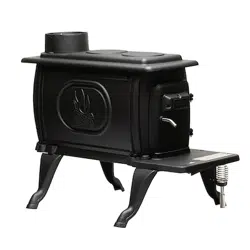Loading ...
Loading ...
Loading ...

-10-
CAUTION: A chimney re may cause ignition of wall studs or rafters which you thought were a safe distance from
the chimney. If you have a chimney re, have your chimney inspected by a qualied person before using again.
SERVICE HINTS
Do not expect a heater to draw. It is the chimney that creates the draft. Smoke spillage into the house or excessive
buildup of water or creosote in the chimney are warnings that the chimney is not functioning properly. Correct
problem before using heater. Possible causes are:
1. The connector pipe may push into the chimney too far, stopping the draft.
2. Do not connect two heaters into the same chimney ue.
3. The chimney used for a heater must not be used to ventilate the cellar or basement. If there is a cleanout
opening at the base of the chimney, it must be closed tightly.
4. If the chimney is operating too cool, water will condense in the chimney and run back into the stove.
Creosote formation will be rapid and may block the chimney. Operate the heater at a high enough re to
keep the chimney warm preventing this condensation.
5. If the re burns well but sometimes smokes or burns slowly, it may be caused by the chimney top being lower
than another part of the house or a nearby tree. The wind blowing over a house or tree, falls on top of the
chimney like water over a dam, beating down the smoke. The top of the chimney should be at least 3 feet
above the roof and be at least to 2 feet higher than any point of the roof within 10 feet.
Woodstove Utilization
Your heating unit was designed to burn wood only; no other materials should be burned. Waste and other
ammable materials should not be burned in your stove. Higher efciencies and lower emissions generally result
when burning air dried seasoned hardwoods, as compared to softwoods or to green or freshly cut hardwoods.
Burning the following materials may result in release of toxic fumes or render the heater ineffective and cause
smoke.
DO NOT BURN:
1. Residential or commercial garbage;
2. Lawn clippings or yard waste;
3. Materials containing rubber, including tires;
4. Materials containing plastic;
5. Waste petroleum products, paints or paint thinners,
or asphalt products;
6. Materials containing asbestos;
7. Construction or demolition debris;
8. Paper products, cardboard, plywood, or
particleboard. The prohibition against burning
these materials does not prohibit the use of re
starters made from paper, cardboard, sawdust,
wax, and similar substances for the purpose of
starting a re in the unaffected wood heater.
9. Railroad ties or pressure-treated wood;
10. Manure or animal remains;
11. Saltwater driftwood or other previously salt water-
saturated materials;
12. Unseasoned wood;
13. Any materials that are not included in the warranty
and owner’s manual for the subject wood heater; or
14. Any materials that were not included in the
certication tests for the subject wood heater.
Do not burn manufactured logs made of wax impregnated sawdust or logs with any
chemical additives. Manufactured logs made of 100% compressed sawdust can be
burned, but be careful burning too much of these logs at the same time. Start with
one manufactured log and see how the stove reacts. You can increase the number
of logs burned at a time making sure the temperature never rises higher than 475 °F
(246 °C) on a magnetic thermometer for installation on single wall stove pipes or 900
°F (482 °C). The thermometer should be placed about 18” (457 mm) above the stove.
Higher temperatures can lead to overheat and damage your stove. Dead wood lying
on the forest oor should be considered wet and requires full seasoning time. Standing
deadwood can usually be considered to be about 2/3 seasoned. Splitting and stacking
wood before it is stored accelerates the drying time. Storing wood on an elevated surface from the ground and
under a cover or covered area from rain or snow also accelerates drying time. A good indicator if the wood is
ready to burn is to check the piece ends. If cracks are radiating in all directions from the center then the wood
should be dry enough to burn. If your wood sizzles in the re, even though the surface is dry, it may not be fully
cured and should be seasoned longer.
Loading ...
Loading ...
Loading ...
